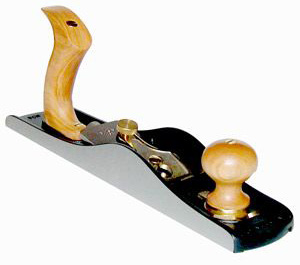 I regularly visit with the customers who attend our Lie-Nielsen events around the country. We have a wide range of attendees, from the well-seasoned woodworker checking if we’ve released a new tool (so they can keep their sets complete) to the new woodworker. We often hear the same question from this latter group: “What is the first plane I should buy?” I like to discuss a customer’s interests and current tools at length so I can provide the best answer. Some who ask this question truly are looking for their first plane, while others are looking to find the best bang for the buck. Many times, both groups will end up finding the #62 Low Angle Jack Plane as a good fit for their needs.
I regularly visit with the customers who attend our Lie-Nielsen events around the country. We have a wide range of attendees, from the well-seasoned woodworker checking if we’ve released a new tool (so they can keep their sets complete) to the new woodworker. We often hear the same question from this latter group: “What is the first plane I should buy?” I like to discuss a customer’s interests and current tools at length so I can provide the best answer. Some who ask this question truly are looking for their first plane, while others are looking to find the best bang for the buck. Many times, both groups will end up finding the #62 Low Angle Jack Plane as a good fit for their needs.
The #62 can be a chimera of sorts, in the plane world. The plane iron is bedded at 12 degrees with the bevel up, and the mouth is easily adjustable, all features recognizable in a Low Angle Block Plane. The length of the plane (14”) kicks it into the Jack Plane category. There are three types of irons available (one standard iron comes with the plane), the standard iron with a 25 degree bevel, the toothing iron and the scraping iron. The low bedding angle of the iron provides excellent end grain planing, with a standard iron honed with a 5 degree micro bevel, finalizing at 30 degrees. With this setup, and the addition of the Hot Dog handle, shooting the ends of boards to that final fit is extremely easy and comfortable. Using the same style standard iron, you can add in some camber and open up the mouth to handle a thicker shaving, and you’re ready to handle some quick stock removal. The toothing iron, with all of its little teeth, works wonderfully on highly figured or crazy grained wood. Since the iron has lots of small teeth, it can remove material without the tendency to dive down into the grain. The surface left by the toothing iron is not what most associate with planing, as it is rough, yet flat. If you follow up use of the toothing iron with a freshly sharpened standard iron, honed at an angle between 30 and 45 degrees, you can make that instrument grade curly maple look like it belongs on that exquisite table/chest of drawers or even high-end guitar. Some woods might not need the extra “toothing” attention, but could still use more than the standard iron alone. For these, the scraping iron can be just the tool for the job. With the low bedding angle, the scraping iron doesn’t sit in the plane like most dedicated scraping planes, but it still presents its edge to the wood in a manner that does a great job.
With the capabilities of the #62, from heavy wood removal in the early stages of stock prep, to finishing wood with a glassy smoothness, to shooting end grain, this is one of the most versatile planes around. If a customer works on smaller scale projects, the length of the #62 could also flatten the wood sufficiently, without the need for a full-sized jointer. Those that are looking for the “most bang for their buck” will easily see why purchasing a #62, along with the additional irons and Hot Dog handle, can make a lot of sense. Even those that don’t think they’ll need the toothing and scraping irons, might include an extra standard iron to keep honed at the higher 45 degrees. This will expedite going between mild grain work to the extreme grain with nothing more than an iron swap.
I hope to see some of you at our events this season, listed on the Lie-Nielsen website.
To take a closer look at the low angle jack plane, click here.
To see Highland Woodworking’s entire selection of Lie-Nielsen hand tools, click here.
Lee Laird has enjoyed woodworking for over 20 years. He is retired from the U.S.P.S. and works for Lie-Nielsen Toolworks as a show staff member, demonstrating tools and training customers.


Do your irons fit in the stanely 62
Hi Joel. The Lie-Nielsen 62 Replacement Irons do not fit a Stanley 62. Sorry!